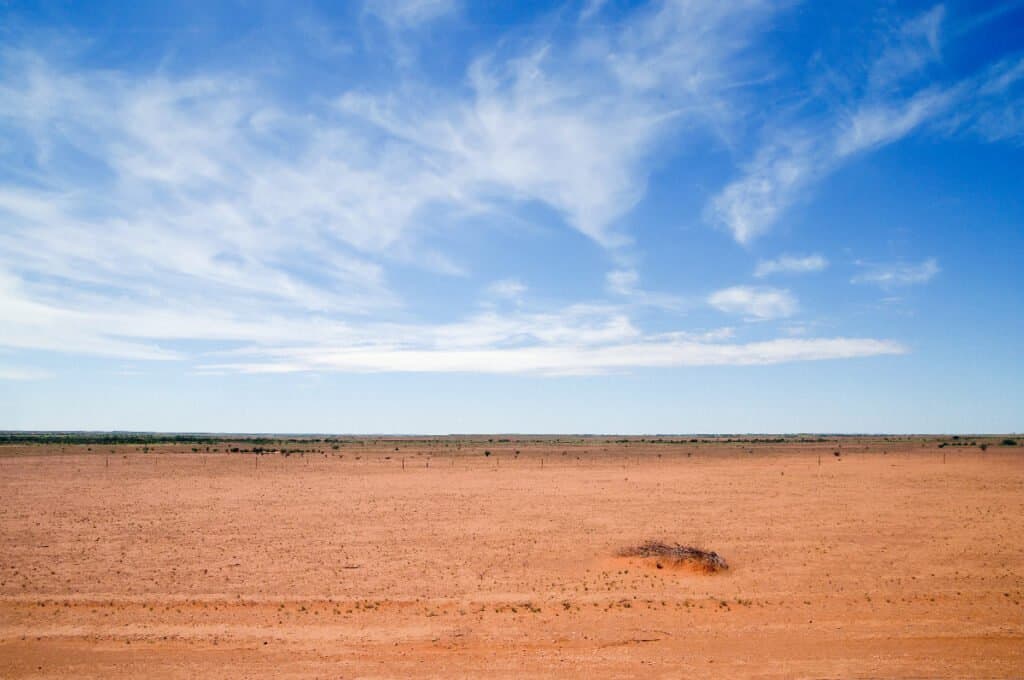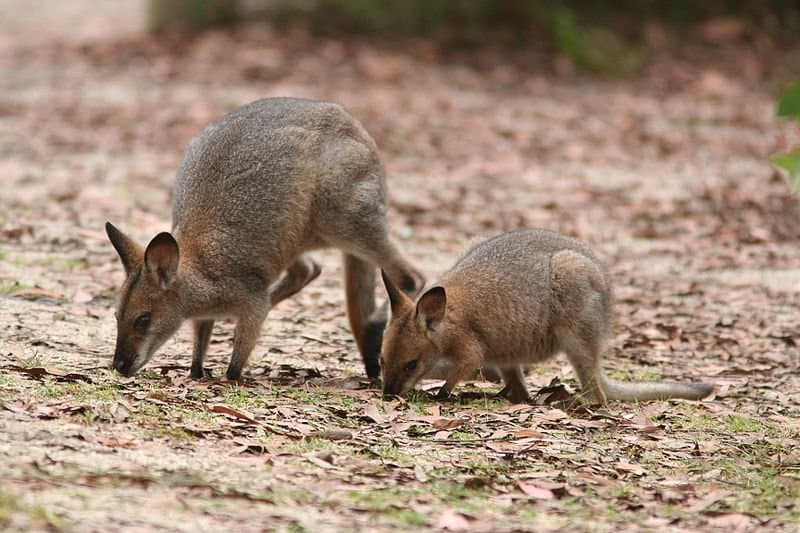Australia is a truly massive region that contains some of the most unique environments and creatures found anywhere in the world. Although the outer edge of the country contains millions of people, the center regions of the continent are sparsely populated. That region with little to no people is collectively known as the Great Australian Desert. Today, we will learn a bit about this desert and what makes it so special.
What is the Great Australian Desert?

There are 10 distinct deserts that make up the Great Australian Desert region.
©iStock.com/idizimage
The Great Australian Desert is a collection of deserts and desert regions in the center regions of the Australian continent, although it is technically made up of smaller deserts and other arid regions. About 18% of the continent is covered in desert, with a further 35% covered in what’s essentially deserts due to its extreme aridity.
Altogether, around 10 primary deserts make up the Great Australian desert, with each ranging between 0.016% and 4.5% of the surface area of the continent. The largest desert is the Great Victoria Desert, and the smallest is the Pedirka Desert.
Central and western Australia have extremely sparse populations, especially in the interior regions. The least populated regions of the Great Australian Desert are some of the most sparsely inhabited places in the world (in regard to humans), although they contain some of the most interesting wildlife.
How Large is the Great Australian Desert?

The Great Australian Desert is the fourth largest desert in the world.
©clearviewstock/Shutterstock.com
Altogether, the Great Australian Desert is around 1,000,000 square miles. Officially recognized desert regions make up around 18% of the total surface area of the continent, although a total of 35% of the continent is dry enough to be considered desert in a more colloquial sense.
The region is known as the fourth largest desert in the world, behind the Antarctic, the Arctic, and the Sahara. Polar regions are technically considered deserts, although they aren’t hot. Without the Antarctic and the Arctic, the Great Australian Desert is the second largest in the world behind only the Sahara.
In addition to the sheer surface area, the Great Australian Desert is one of the oldest and most unchanged regions in the world. Additionally, around 40% of the desert is covered in sand dunes, making the continent one of the most infertile places in the entire world by the surface area of fertile soil.
Where is the Great Australian Desert located?
As the name suggests, the Great Australian Desert is located in Australia. It’s important to know, however, that the desert isn’t a single region, but a group of 10 deserts spread across the center of the continent. The largest portions of the desert are found in the Western Plateau and the interior of the country. Regions covered by some portion of the desert include South West Queensland, the Far West region of New South Wales, Sunraysia in Victoria, Spencer Gulf in South Australia through the Barkly Tableland in Northern Territory, and the Kimberley region in Western Australia.
Within the various regions are different geological and biological landscapes. Common geographical regions include mountains, salt pans, stone deserts, red sand dunes, sandstone mesas, rocky plains, salt lakes, and more.
The ten deserts that make up the collective region are, from largest to smallest, include:
| Desert Name | Region Located |
|---|---|
| The Great Victoria Desert | South Australia and Western Australia |
| The Great Sandy Desert | Northern Territory and Western Australia |
| The Tanami Desert | Northern Territory and Western Australia |
| The Simpson Desert | Northern Territory, Queensland, and South Australia |
| The Gibson Desert | Western Australia |
| The Little Sandy Desert | Western Australia |
| The Strzelecki Desert | New South Wales, Queensland, and South Australia |
| The Sturt Stony Desert | Queensland and South Australia |
| The Tirari Desert | South Australia |
| The Pedirka Desert | South Australia |
Climate in the Great Australian Desert

The Great Australian Desert receives around 9.8 inches of rain a year, although this can vary.
©iStock.com/Totajla
Deserts are created from a lack of water and moisture, and the Great Australian Desert is no different. Even still, the various deserts collectively receive more rain than most other true deserts, but the high level of evapotranspiration that occurs nullifies the extra moisture. Altogether, Australia is the driest overall continent in the world.
The average rainfall in the Great Australian Desert is around 9.84 inches a year. For reference, the Sahara receives around 3 inches of rainfall a year. Additionally, the interior of the continent is relatively stable and isn’t as influenced by the wet and dry seasons that are more common to the northern regions. Still, the wet season comes with thunderstorms that sweep across the land from April to September.
During the summer, the desert regions of Australia are regularly recorded between 90 and 104 degrees F. Winter brings slightly cooler temperatures, but it is mostly regional. Places impacted by winter can range from 64-73 degrees during the day. At night, the deserts lose much of their heat, dropping to around 43 degrees in many instances.
The hottest temperature ever recorded in Australia occurred on January 13th of 2022, coming in at 123.3 degrees F. The coldest temperature ever recorded in Australia was -9.4 degrees F on January 2nd, 1960.
Wildlife in the Great Australian Desert

The Great Australian Desert is home to some of the most unique and isolated creatures on the planet.
The Great Australian Desert may be uninhabited by humans, but it is still one of the most diverse places on earth. In fact, the desert is so isolated that it has some of the highest numbers of endemic species found anywhere in the world.
The interior of Australia has the world’s largest population of feral camels. Other mammals in the region include dingoes, wombats, wallabies, kangaroos, and more. Reptiles include bearded dragons, thorny devils, frogs, and more. Birds that live in the desert include emus, parrots, cockatoos, owls, and more.
Despite the overall aridity and spare population of the Great Australian Desert, the region is home to some of the rarest and most unique creatures found anywhere else. Conservation of the region is extremely important to preserve its immense biodiversity.
What to do and see in the Great Australian Desert

The Great Australian Desert has some of the most beautiful national parks in the world.
©iStock.com/Claudia Schmidt
Although the arid desert is extremely dry and hot, some regions have a thriving tourism industry. There are around a million tourists that visit the Northern Territory each year. Within the parks are camping sites, hiking trails, and a lot more. Tours are centered around the natural beauty of the region, as well as the excursions available. Additionally, people come to see wildlife that can only be found in the deserts of Australia.
Even more, there are famous fossil sites across the region that tourists and researchers alike travel to see and explore. The most famous tourist destinations in the Great Australian Desert include:
- Arkaroola and Wilpena Pound in the Flinders Ranges
- Australian Stockman’s Hall of Fame
- Devils Marbles
- Kakadu National Park
- Kata Tjuta (The Olgas)
- Katherine Gorge
- Kings Canyon (Watarrka)
- MacDonnell Ranges
- Monkey Mia
- Mount Augustus National Park
- Uluru (Ayers Rock)
- Willandra Lakes Region
- Lake Mungo
- Gawler Ranges National Park
- Gawler Ranges Conservation Park
- Great Victoria Desert Nature Reserve
- Lake Gairdner National Park
- Mamungari Conservation Park
- Munga-Thirri National Park
- Karlamilyi National Park
- Mount Willoughby Indigenous Protected Area
- Nullarbor Regional Reserve
- Pureba Conservation Park
- Queen Victoria Spring Nature Reserve
- Tallaringa Conservation Park
- Watarru Indigenous Protected Area
- Yellabinna Regional Reserve
- Yellabinna Wilderness Protection Area
- Yumbarra Conservation Park
- Black Rock Conservation Park
- Bon Bon Station Conservation Reserve
- Bunkers Conservation Reserve
- Caroona Creek Conservation Park
- Coongie Lakes Ramsar Site
- Danggali Wilderness Protection Area
- Ediacara Conservation Park
- Elliot Price Conservation Park
- Gawler Ranges National Park
- Hiltaba Nature Reserve
- Ikara-Flinders Ranges National Park
- Ironstone Hill Conservation Park
- Kanku-Breakaways Conservation Park
- Kati Thanda-Lake Eyre National Park
- Kinchega National Park
- Lake Frome Regional Reserve
- Lake Gairdner National Park
- Lake Gilles Conservation Park
- Lake Torrens National Park
- Mount Brown Conservation Park
- Mount Willoughby Indigenous Protected Area
- Munyaroo Conservation Park
- Mutawintji National Park
- Nantawarrina Indigenous Protected Area
- Pandappa Conservation Park
- Pinkawillinie Conservation Park
- Pualco Range Conservation Park
- Simpson Desert Regional Reserve
- Strzelecki Regional Reserve
- Sturt National Park
- The Dutchmans Stern Conservation Park
- Vulkathunha-Gammon Ranges National Park
- Wabma Kadarbu Mound Springs Conservation Park
- Whyalla Conservation Park
- Winninowie Conservation Park
- Witchelina Nature Reserve
- Witjira National Park
- Yalpara Conservation Park
- Yellabinna Regional Reserve
- Yellabinna Wilderness Protection Area
- Yumbarra Conservation Park
Up Next
- This is The Largest Desert In Africa
- The 15 Largest Deserts in the World
- The 9 Deadliest and Most Dangerous Deserts on Earth
The photo featured at the top of this post is © iStock.com/idizimage
Thank you for reading! Have some feedback for us? Contact the AZ Animals editorial team.






